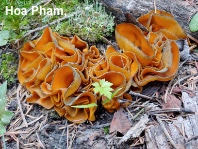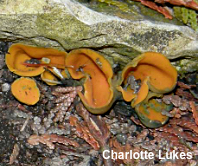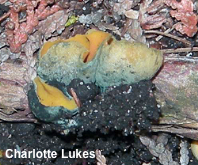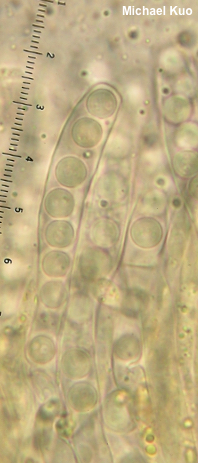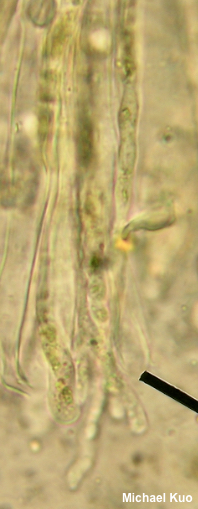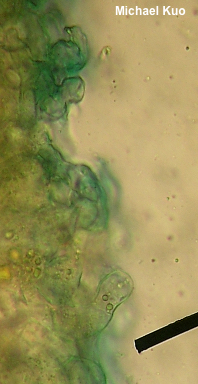| Major Groups > Cup Fungi > Caloscypha fulgens |

|
Caloscypha fulgens [ Ascomycota > Pezizales > Caloscyphaceae > Caloscypha ... ] by Michael Kuo A springtime cup fungus with orange surfaces that bruise and discolor blue to green, Caloscypha fulgens is found under conifers across North America, but it is much more frequently seen west of the Rockies. It is partial to wet areas like conifer bogs and, in the west, is often found where mountain snowbanks have recently melted. Species of Aleuria (for example Aleuria aurantia) can appear similar to Caloscypha fulgens, but do not stain blue to green and are not limited to damp conifer substrates in spring; they also differ substantially under the microscope. Caloscypha fulgens includes the sexual teleomorph described and illustrated here—as well as its asexual anamorph, which was traditionally given the name "Geniculodendron pyriforme" (before current taxonomic rules required one scientific name for a fungus with two sexual stages). The asexual stage is found acting as a pathogen on the seeds of spruces and pines, usually when the seeds are nested within decaying cones, and is not recognizable except to specialists; it appears as a mass of hyphae that develop conidia. An albino version of Caloscypha fulgens is sometimes encountered, growing alongside the orange version, or growing by itself. It is sometimes given the name Caloscypha fulgens f. caesioalba. Thanks to Charlotte Lukes and Hoa Pham for collecting, documenting, and preserving Caloscypha fulgens for study; their collections are deposited in The Herbarium of Michael Kuo. Description: Ecology: Parasitic on the seeds of conifers (see discussion above); growing gregariously or in clusters in duff on the ground under conifers, usually in low-lying, wet areas; spring and early summer; widely distributed in North America but much more common from the Rocky Mountains westward. The described and illustrated collections are from Wisconsin and Colorado. Fruiting Body: Cup- to saucer-shaped; 2–5 cm across; upper surface bald, dull to bright orange, discoloring bluish to greenish; flesh orangish, 1–2 mm thick; undersurface finely granular when fresh, or with a whitish bloom, sometimes becoming more or less bald, pale orange, bruising and discoloring blue to green, especially at the edge of the cup. Odor: Not distinctive. Microscopic Features: Spores 5–6 µm; globose; smooth; hyaline in KOH. Asci 8-spored; up to 125 µm long; hyaline in KOH; tips inamyloid. Paraphyses filiform; 3–4 µm wide; apices rounded or subclavate; hyaline in KOH, or with dull to bright yellow, globular contents. Excipular surface nearly hymeniform-cellular in appearance; elements smooth, hyaline or blue in KOH; terminal cells subglobose to cylindric, 10–15 µm wide. REFERENCES: (Persoon, 1822) Boudier, 1885. (Seaver, 1942; Salt, 1974; Paden et al., 1978; Rogers & Bonman, 1978; Breitenbach & Kränzlin, 1984; Arora, 1986; Phillips, 1991/2005; Lincoff, 1992; Barron, 1999; Hobbie, Weber & Trappe. 2001; Miller & Miller, 2006; Trudell & Ammirati, 2009; Desjardin, Wood & Stevens, 2015; Evenson, 2015; Cripps, Evenson & Kuo, 2016; Beug et al., 2014.) Herb. Kuo 05171901, 05291901. This site contains no information about the edibility or toxicity of mushrooms. |
© MushroomExpert.Com |
|
Cite this page as: Kuo, M. (2019, August). Caloscypha fulgens. Retrieved from the MushroomExpert.Com Web site: http://www.mushroomexpert.com/caloscypha_fulgens.html |
